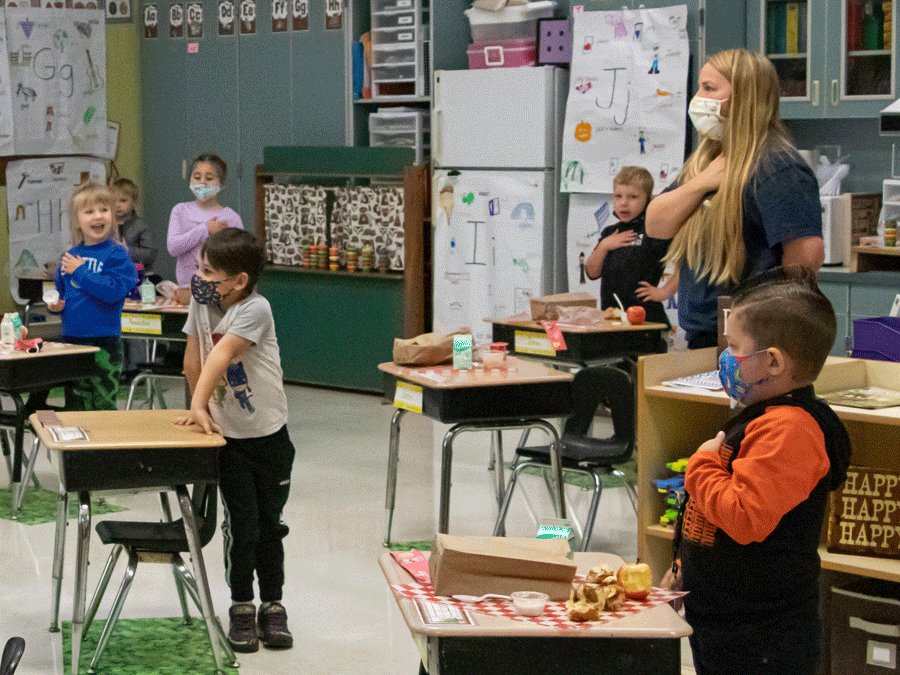
Emilie Marchio, who has taught kindergarten at Vaughn Elementary School for six years, was delighted to welcome more than a dozen 5-year-olds to class. “I love it. As strange and weird as it is, I am grateful to be in class to see the light bulb moments,” she said.
“It was so wonderful to hear children’s voices from the playground again,” said Marci Cummings-Cohoe, who is in her own Vaughn classroom teaching second-grade remotely.
Vaughn Elementary opened Sept. 8 with a small number of high-needs students in its Options Program and developmental preschool. But adding three classes each of kindergarten and first-graders Sept. 28 more than quintupled the number of students.
Vaughn is one of three elementary schools in the district and the only one on the Key Peninsula with the Options Program, which serves high-needs students. They are primarily in a self-contained classroom and join regular classes as they are able.
Bringing the school’s youngest students back to the classroom took weeks of planning. Staff mapped out classrooms to see exactly how many students could fit and still satisfy the 6-foot distancing requirement. They planned how to greet and screen each student in the morning, how to move students from one place to another, and how recess would work.
Principal Abbie Barabe communicated at length with parents, showing them pictures of classrooms to be sure they were comfortable with the safety measures the school had in place. She also emphasized how critical it is to keep students at home if they are sick.
“Parents were totally on board and ready to bring their kids to the classroom by the time school opened,” Barabe said. “The kids rock it. They totally get it. They are masked up, ready to go. They are patient.”
There are challenges. The first day it took 20 minutes to get all the students into the building. By the end of the week it was down to five.
Students spend the day with their classroom cohort. Lunch is served in the classroom. Specialist teachers come to them rather than having the class move to another room. The playground is marked into areas so that each class stays within a given space. Some Hula Hoop-sized areas are marked off so that students can take a “mask break” if they need one.
Kindergarten teacher Kate Chaffin said her kids are resilient and flexible, but also seem a bit more vigilant and worried than in the past.
“I find myself saying ‘Give yourself a hug,’ ” she said, contrasting it to times in the past when a group hug might be in order.
Cummings-Cohoe said that online teaching has gone better than she had expected, though she looks forward to the day when students can return to the classroom. She is working to build relationships with her students, and they have also been able to build relationships with each other, often chatting before a Zoom class starts. Reflecting on her experience with her own fifth- and seventh-grade children, she said “Kids are more resilient than we give them credit for. They strive past my limits.”
Lisa and Matt Mills are specialists at Vaughn, teaching music and STEM respectively. “We grew up here and we have both taught for 30 years. What has happened in the last year has been a mind-bender,” Lisa said.
“We walk between all these worlds,” Matt said. “We’re parents, though our kids have graduated. We have the needs of the school district and the board — that’s really our job description — we have the needs of our families, and we also have our fellow staff. And then there is what the health department requires. If you don’t get frustrated, it’s a very interesting problem to solve.”
Lisa said that immersing herself in learning how to teach virtually has improved her game. She is making every minute count, rethinking how to teach music when, for the time being, singing is not allowed. She and Matt both teach from carts so that they can take lessons to each classroom. When it is time to teach online they go back to the classroom and teach from their carts in front of a camera, sometimes with just a 5-minute turnaround.
“I am teaching with ferocity,” Lisa said. “Teaching will never be the same.”
Matt has noticed that online classes have been a benefit for some students.
“When the class is on Zoom it’s more like a one-on-one experience for each student,” he said. “For some of those quiet kids, they say things they would never say in regular class.”
Barabe noted that of the students online, about 25% are not fully engaged — some for psychosocial reasons and some due to poor internet access. She said she worries about those students who have not enrolled and whose families have not made plans to homeschool or participate in other online options.
Looking ahead Barabe said, “We could be faced with a challenge long term. We committed to the families that in January we would open the opportunity to come back in person. If distancing guidelines haven’t changed, I may not have enough room or enough teachers. If we could have 3 feet apart as a recommendation for desks in the classroom, we would have more access.”
UNDERWRITTEN BY THE FUND FOR NONPROFIT NEWS (NEWSMATCH) AT THE MIAMI FOUNDATION, THE ANGEL GUILD, ADVERTISERS, DONORS AND PEOPLE WHO SUPPORT INDEPENDENT, NONPROFIT LOCAL NEWS